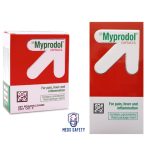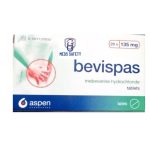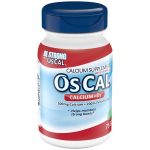Nalgesin: Uses, Benefits, Dosage, Side Effects, Interactions

Nalgesin is an over-the-counter pain relief medication containing the active ingredient Naproxen. This medication is commonly sold and distributed in Romania, Slovenia, and many other countries.
Naproxen, the active ingredient in Nalgesin, belongs to the NSAID class of medications. These drugs are known for their ability to alleviate pain, reduce inflammation, and lower fever. Nalgesin achieves these effects by inhibiting the production of prostaglandins, chemicals in the body that are responsible for causing pain and inflammation in response to injury or illness.
Nalgesin has a broad spectrum of uses, including the management of various types of pain, such as headaches, toothache, menstrual cramps, arthritis, and muscle aches. Another benefit of Nalgesin is that it can also be used in the control of inflammation in conditions like rheumatoid arthritis and osteoarthritis. What sets Nalgesin apart is its relatively long-lasting pain relief, which allows individuals to take fewer doses compared to some other common NSAIDs.
Dosage
Dosages of Nalgesin can vary depending on the specific condition being treated. It’s crucial to follow your healthcare provider’s recommendations or the instructions on the medication label. Nalgesin is available in 2 dosage forms:
1. Nalgesin 220mg Dosage: The typical recommended dosage for Nalgesin 220mg is usually one tablet (220mg) taken orally, every 8 to 12 hours as needed for pain relief. This dosage is commonly used for mild to moderate pain or to reduce inflammation associated with conditions like osteoarthritis, rheumatoid arthritis, or menstrual cramps.
2. Nalgesin 275mg Dosage: Nalgesin 275mg tablets are typically taken in a dosage of one tablet (275mg) taken orally every 8 to 12 hours, as needed for pain relief. This dosage may be prescribed for more severe pain or for individuals who require a higher dose to effectively manage their pain or inflammation.
It’s important to note that the specific dosage and frequency of Nalgesin can vary based on an individual’s medical condition, age, weight, and other factors. Therefore, it’s essential to follow your healthcare provider’s instructions or the dosing information provided on the medication label. Additionally, taking Nalgesin with food or milk can help reduce the risk of stomach upset. If you have any questions or concerns about the appropriate dosage of Nalgesin for your condition, it’s advisable to consult with your healthcare provider or pharmacist for personalized guidance.
Side Effects of Nalgesin
Nalgesin can cause various side effects, ranging from mild to severe. It’s important to be aware of these potential side effects and to consult your healthcare provider if you experience any unusual or severe symptoms. Common side effects of Nalgesin may include:
1. Gastrointestinal Issues: Naproxen can irritate the stomach lining, leading to symptoms such as indigestion, heartburn, abdominal pain, nausea, or in some cases, ulcers and gastrointestinal bleeding.
2. Headache: Some individuals may experience headaches as a side effect of Naproxen.
3. Dizziness or Drowsiness: Nalgesin can cause dizziness or drowsiness in some people. It’s important to avoid activities that require mental alertness, such as driving or operating heavy machinery, if you are affected.
4. Fluid Retention: Naproxen may cause fluid retention in some individuals, leading to swelling of the hands, ankles, or feet.
5. High Blood Pressure: It can occasionally elevate blood pressure, especially with prolonged use or in individuals with pre-existing hypertension.
6. Kidney Function: Naproxen can affect kidney function, leading to reduced urine output or changes in urine color.
7. Allergic Reactions: Although rare, some individuals may experience allergic reactions to Nalgesin, which can manifest as rash, itching, swelling, or difficulty breathing. Seek immediate medical attention if you experience these symptoms.
8. Liver Problems: While uncommon, Naproxen can affect liver function. Watch for signs such as yellowing of the skin or eyes, dark urine, or persistent nausea.
9. Bleeding: Naproxen, like other NSAIDs, can increase the risk of bleeding, both internally (gastrointestinal bleeding) and externally (e.g., nosebleeds or easy bruising).
10. Heart and Cardiovascular Effects: Long-term use or high doses of NSAIDs like Naproxen can increase the risk of heart attack, stroke, or other cardiovascular issues, especially in individuals with underlying heart conditions.
11. Hearing Changes: Some rare cases have reported hearing changes or ringing in the ears (tinnitus) with Naproxen use.
12. Skin Reactions: Skin reactions, such as blistering or peeling, can occur but are relatively uncommon.
It’s important to note that the severity and occurrence of these side effects can vary from person to person. To minimize the risk of side effects, follow your healthcare provider’s instructions regarding the dosage and duration of Nalgesin use. Additionally, inform your healthcare provider of any other medications or supplements you are taking to avoid potential drug interactions. If you experience severe or persistent side effects, or if you have concerns about the safety of Nalgesin, consult with your healthcare provider promptly. In some cases, they may recommend alternative pain relief options or adjustments to your treatment plan.
Interactions
Nalgesin can interact with various medications and substances. These interactions can affect the effectiveness of Nalgesin or increase the risk of side effects. It’s essential to inform your healthcare provider about all the medications, supplements, and herbs you are taking to ensure safe and effective use of Nalgesin. Here are some common interactions to be aware of:
1. Other NSAIDs (Nonsteroidal Anti-Inflammatory Drugs): Combining Nalgesin with other NSAIDs, such as ibuprofen or aspirin, can increase the risk of gastrointestinal bleeding and ulcers. It’s generally advisable to avoid using multiple NSAIDs simultaneously.
2. Blood Thinners (Anticoagulants and Antiplatelet Drugs): Taking Nalgesin with blood-thinning medications like warfarin, clopidogrel, or aspirin can increase the risk of bleeding. Your healthcare provider may need to adjust your medication dosages and monitor your blood closely if you are on these combinations.
3. Corticosteroids: Concurrent use of Nalgesin and corticosteroids (e.g., prednisone) may increase the risk of gastrointestinal bleeding and ulcers.
4. Selective Serotonin Reuptake Inhibitors (SSRIs): Combining Nalgesin with SSRIs, commonly used antidepressants like fluoxetine or sertraline, can increase the risk of gastrointestinal bleeding.
5. Antihypertensive Medications: Nalgesin may reduce the effectiveness of certain blood pressure medications. Be sure to discuss this interaction with your healthcare provider if you are taking medications for hypertension.
6. Lithium: Nalgesin can increase the levels of lithium in the blood, potentially leading to lithium toxicity. If you are on lithium therapy, your lithium levels should be closely monitored.
7. Methotrexate: Concurrent use of Nalgesin and methotrexate, often used for rheumatoid arthritis and certain cancers, can lead to increased methotrexate levels and potential toxicity. Adjustments to methotrexate dosages may be necessary.
8. Diuretics (Water Pills): Nalgesin may reduce the effectiveness of diuretics and increase the risk of kidney problems when used together.
9. Alcohol: Alcohol can increase the risk of gastrointestinal bleeding when taken with Nalgesin. It’s best to avoid alcohol or limit its consumption while using this medication.
10. Herbal Supplements: Some herbal supplements, such as ginkgo biloba and garlic, can increase the risk of bleeding when taken with Nalgesin. Discuss any herbal supplements with your healthcare provider.
11. Antacids: Taking Nalgesin with antacids may reduce the absorption of the medication. It’s generally recommended to take Nalgesin with food or milk to minimize stomach irritation.
12. Cyclosporine: Concurrent use of Nalgesin and cyclosporine can lead to kidney problems. If you are on cyclosporine therapy, your healthcare provider should closely monitor your kidney function.
These are not exhaustive lists of interactions, and there may be other medications or substances that can interact with Nalgesin. Always consult your healthcare provider or pharmacist before starting or stopping any medication, and inform them of your complete medication history to ensure safe and effective pain relief while using Nalgesin. Your healthcare provider can provide personalized guidance on how to manage these interactions and adjust your treatment plan as needed.





